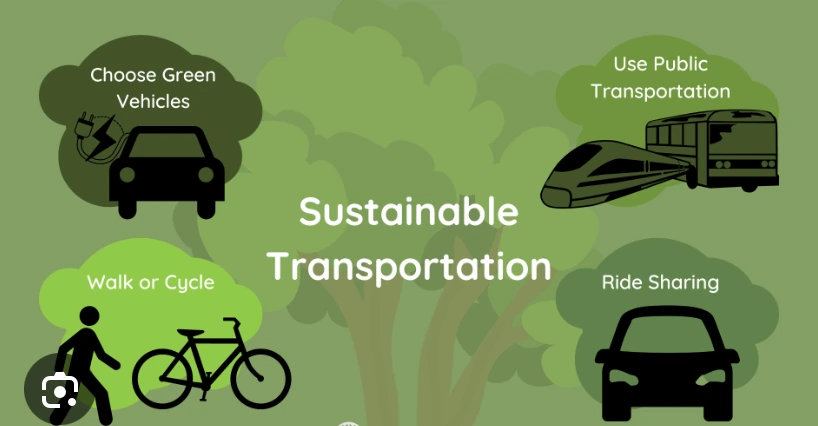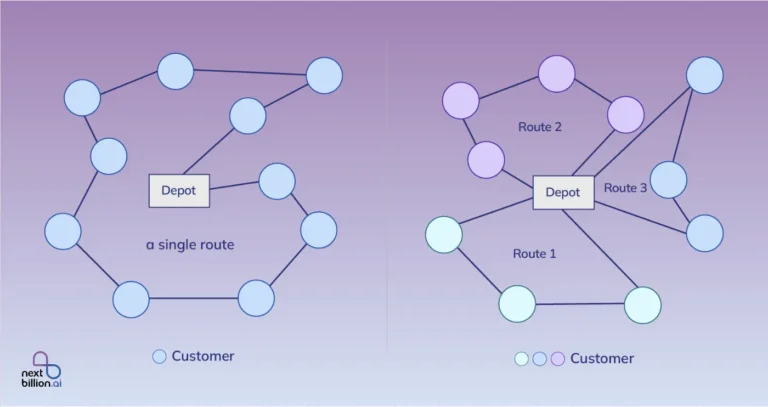
Table of Contents
Green transportation refers to environmentally friendly modes of travel methods that lower emissions, conserve energy, and reduce the environmental footprint of transporting people and goods. It includes electric vehicles (EVs), public transit, cycling, walking, and other sustainable options aimed at decreasing dependence on fossil fuels. Focusing on efficiency, renewable energy, and smart infrastructure design, green transportation or green commuting promotes cleaner air, reduces traffic congestion, and supports the growth of sustainable urban areas. By embracing these environmentally conscious solutions, green transportation plays a vital role in combating climate change and fostering healthier, more resilient communities.

Significance of Green Transportation
The significance of green transportation to address various environmental, economic, and social concerns makes it significant. Here are the key reasons why green transportation is important:
Reduction of Greenhouse Gas Emissions: One of the biggest producers of greenhouse gas emissions worldwide is the transportation industry, and green transportation is essential to lowering its carbon footprint. By switching to zero- or low-emission vehicles (such as electric cars or bicycles), you can mitigate climate change by reducing emissions of carbon dioxide (CO₂) and other pollutants.
Improved Air Quality: Traditional vehicles emit harmful pollutants like nitrogen oxides (NOx) and particulate matter, which contribute to air pollution and respiratory health issues. Green transportation reduces these emissions, improving air quality and reducing the incidence of health problems such as asthma, bronchitis, and heart diseases.
Energy Conservation: Green transportation encourages the use of more energy-efficient cars and renewable energy sources, such as wind or solar power, to cut down on the usage of fossil fuels like gas and oil. This helps conserve nonrenewable energy resources and decreases dependency on oil, which can enhance energy security for countries.
Cost Savings: Adopting green transportation methods, such as public transit, biking, or using electric vehicles, can lead to lower operational and fuel costs. Electric vehicles, for instance, have lower maintenance costs compared to traditional internal combustion engine vehicles. Reduced fuel consumption also translates into economic savings, both for individuals and governments.
Urban Mobility and Reduced Traffic Congestion: Green transportation systems, including well-designed public transportation and shared mobility options, help reduce the number of vehicles on the road. This leads to less traffic congestion, reduced commuting times, and improved urban mobility, making cities more livable and efficient.
Reduction of Noise Pollution: Electric vehicles, bicycles, and public transport systems like electric trains produce far less noise than traditional cars and trucks. Reducing noise pollution improves the quality of life, especially in densely populated urban areas.
Economic Growth and Job Creation: The shift to green transportation supports the growth of industries related to renewable energy, electric vehicles, public transit systems, and sustainable urban planning. This fosters economic innovation and can create new job opportunities in fields like renewable energy transportation, infrastructure development, and technology.
In summary, green transportation is significant for its environmental benefits, health improvements, energy conservation, cost savings, and its role in supporting sustainable urban development and economic growth. It is a critical component of a future where mobility is aligned with sustainability goals.
Different Modes of Sustainable (Green) Transportation Vehicles
Different types of environmentally friendly sustainable transportation vehicles are becoming more and more important, particularly in places where traffic congestion and urbanisation are major issues. By adopting these various modes of green transportation, these countries can move towards more sustainable urban environments, reduce traffic congestion, and improve air quality. Each mode serves as a vital building block in developing a greener future for transportation. Here are some of the key modes:
For delivery industry
1. Bicycle
Some cities have introduced bicycle-sharing programs, encouraging people to use bikes for short trips, which not only cuts down emissions but also promotes a healthy lifestyle. Bicycle commuting also enhances health.
2. Electric vehicles
Electric Vehicles (EVs) run on electricity, reducing reliance on fossil fuels and producing zero tailpipe emissions. For example, Tata Motors in India (with the Tata Nexon EV) and Ather Energy (electric scooters) are prominent players. Electric Rickshaws (E-Rickshaws) provide an affordable, eco-friendly alternative for short-distance transportation, cutting down on fuel consumption and air pollution.
3. Electric bikes
Electric bicycles (e-bikes) provide an energy-efficient and low-impact alternative to motorized vehicles.
4. Hybrid vehicles
Hybrid vehicles use a combination of an internal combustion engine and an electric motor. Hybrid cars offer reduced emissions and better fuel efficiency. They serve as a transitional option towards fully electric vehicles.
For personal use
1. Green trains
Railways in some countries such as India are undergoing electrification across many of its routes, with plans to fully electrify by 2030. This will drastically reduce the railway’s carbon footprint, as trains will run on electricity rather than diesel. Some Governments have also experimented with solar-powered trains, where solar panels installed on train coaches generate electricity to power lights and fans inside the train, reducing dependence on conventional energy sources.
2. Carpooling
Carpooling platforms such as Ola, Uber, and BluSmart (Eg: India’s first all-electric cab service) are promoting ride-sharing and electric vehicle (EV) fleets. This reduces the number of vehicles on the road and lowers per-capita emissions.
3. Public transport
Many cities in India, including Delhi, Pune, and Bengaluru, are adopting electric buses or buses powered by Compressed Natural Gas (CNG) for public transit. These vehicles significantly reduce pollution and offer a more sustainable solution for mass transportation. Metro Rail Systems powered by electricity, help reduce the number of private vehicles on the road, alleviating both traffic congestion and pollution.
4. Walking
Adopting pedestrian-friendly sidewalks and dedicated zones for non-motorized transport is crucial for promoting walking as a mode of transportation. Many countries have started designing their cities to accommodate walking.
Benefits of Sustainable Transportation
Numerous benefits of sustainable transportation have a good effect on the economy, society, and environment. These advantages lessen the negative effects of conventional transportation systems, which mostly rely on fossil fuels. The main benefits of sustainable transportation are as follows:
- Sustainable transportation, such as electric vehicles (EVs) and public transit, helps lower carbon dioxide (CO₂) and other greenhouse gas emissions. By doing this, the transportation industry’s carbon footprint is reduced.
- By reducing reliance on fossil fuels, sustainable transportation methods lower pollutants like nitrogen oxides (NOx) and particulate matter, resulting in cleaner and improved air quantity. This reduces the incidence of respiratory issues and other health problems.
- Sustainable transportation reduces the consumption of non-renewable resources, such as oil and gas. By relying on renewable energy sources (solar, wind, etc.) or alternative fuels like hydrogen and biofuels, it helps conserve natural ecosystems and biodiversity.
- Sustainable transportation methods, like EVs and mass transit systems, use energy more efficiently than traditional cars. This reduces fuel consumption and overall energy costs, making the transportation system more economical.
- The transition to sustainable transportation is fueling innovation across industries like electric vehicle manufacturing, renewable energy, and public transit development. This transformation is opening up new business opportunities and generating green jobs in areas such as EV production, charging infrastructure installation, and public transportation services.
- Reduced emissions lead to cleaner air, improving respiratory and cardiovascular health. Sustainable transportation options such as cycling and walking further encourage physical activity, helping combat sedentary lifestyles and contributing to healthier communities.
- Walkable neighborhoods, bike lanes, and reliable public transit foster stronger community ties by encouraging people to spend more time in shared spaces, enhancing social interactions and community engagement. This also helps bridge the gap between communities, making mobility more inclusive and equitable.
- By shifting towards renewable energy and alternative fuels, sustainable transportation decreases dependency on imported fossil fuels. This enhances energy security and reduces the vulnerability of economies to global oil price fluctuations.
- Sustainable transportation is a key component of smart cities, which use technology and data to optimise urban living. Efficient public transit, bike-sharing programs, and pedestrian-friendly infrastructure help reduce urban sprawl and encourage more sustainable land-use planning.
- Sustainable transportation systems offer greater resilience to climate change impacts. Electric vehicles and systems powered by renewable energy can remain operational during disruptions to oil supplies caused by natural disasters or geopolitical conflicts, ensuring more reliable transportation.
In conclusion, sustainable transportation not only reduces emissions and pollution, benefiting the environment, but also enhances public health and quality of life. It drives economic growth, strengthens energy security, and promotes more resilient and sustainable urban development. Together, these benefits contribute to a cleaner, healthier, and more efficient transportation system for the future.
Ideas for a Green Transportation Infrastructure
Developing green transportation infrastructure is crucial for building sustainable cities and minimising the environmental impact of transportation systems. Here are some key strategies for advancing green transportation infrastructure:
- Electric Vehicle (EV) Charging Points: Installing a broad network of public and private charging stations, drivers can enjoy the convenience of charging their vehicles at various locations, including gas stations, shopping centres, workplaces, and residential areas. Fast-charging hubs at these locations make it easier for EV owners to keep their vehicles charged without disruption, thereby addressing range anxiety, one of the primary concerns for potential EV buyers.
Integrating solar panels into EV charging stations can generate clean electricity, reducing reliance on traditional power grids that may still depend on non-renewable energy sources. Solar-powered charging stations are especially beneficial in regions with abundant sunlight, offering a more sustainable way to support EV infrastructure. This approach not only minimises the environmental footprint of EV charging but also increases energy independence and resilience.
- Public Transit Development: Transitioning bus fleets from diesel-powered engines to electric or hybrid models reduces air pollution and greenhouse gas emissions. Expanding light rail and metro networks can provide a clean, efficient mode of transportation for urban commuters, particularly in congested cities. These systems should be powered by renewable energy whenever possible.
- Cycling and Walking Pathways: Developing extensive networks of dedicated, protected bike lanes encourages cycling as a safe and practical mode of transportation. Establishing bike-sharing programs with easily accessible rental stations across cities promotes short-distance cycling. Electric bikes (e-bikes) can be included for those who need additional assistance on hilly terrain or longer commutes.
- Integrated Public Transit Hubs: Creating transportation hubs where buses, trains, bikes, and car-sharing services converge enables seamless transitions between different modes of transport.
- Renewable Energy for Transportation: Some countries are developing highways with built-in charging capabilities for electric vehicles (dynamic charging), allowing EVs to charge while in motion. These “electrified roads” reduce the need for long stops and make electric vehicle travel more feasible over long distances.
- Green Logistics Infrastructure: Creating centralized logistics hubs on the outskirts of cities reduces the number of large trucks entering city centres. Smaller, more fuel-efficient vehicles or electric delivery bikes can handle last-mile delivery, reducing emissions in congested areas. Encouraging logistics companies (such as NextBillion.ai) to switch to electric vans, trucks, and drones for deliveries will reduce carbon emissions in the freight sector. Infrastructure investments in EV charging points for delivery vehicles will support this transition.
- Car-Sharing and Ride-Sharing Infrastructure: Creating dedicated lanes for carpoolers and ride-sharing vehicles incentivizes the use of shared mobility options.
- Waterway Transportation System: Developing electric or hybrid ferries and boats for short-distance travel in coastal areas or along rivers can reduce emissions from water transport.
Creating green transportation infrastructure demands a holistic approach that merges modern technology, renewable energy, and intelligent urban planning. By prioritising these strategies, cities and nations can lower environmental impacts, boost air quality, promote public health, and develop more sustainable transportation systems for future generations.
How Nextbillion.ai Can Help You Develop Sustainability in Transportation?
NextBillion.ai can significantly enhance sustainability in transportation through its comprehensive suite of solutions. Its advanced route optimization technology maximises fuel efficiency by reducing fuel consumption and minimising unnecessary mileage, contributing to reduced carbon emissions. With dedicated support for electric vehicles (EVs), including EV route planning and electric fleet management, it ensures that EVs follow energy-efficient routes and charging schedules. NextBillion.ai offers solutions for public transit and shared mobility services, enabling more sustainable commuting options by incorporating real-time traffic data. By this, vehicles can avoid traffic jams, reducing the time spent idling in traffic, which also lowers emissions. NextBillion.ai’s mapping tools can assist in integrating multi-modal transportation, enabling seamless transitions between walking, biking, public transit, and ride-sharing options. Furthermore, its platform supports the development of bicycle and pedestrian routes, encouraging eco-friendly transport alternatives such as bicycle commuting and walking. By optimizing delivery routes for e-commerce, courier services, and grocery deliveries, NextBillion.ai helps reduce vehicle miles travelled (VMT), fuel use, and emissions.
The NextBillion.ai platform’s carbon emission monitoring and tracking features enable businesses to assess and manage their environmental impact, further promoting sustainable transportation practices. NextBillion.ai can create geofences around eco-friendly zones or low-emission areas, ensuring that certain types of vehicles (like EVs) are routed through these areas, while polluting vehicles avoid them. NextBillion.ai’s solutions for managing transportation fleets, especially in sectors where sustainability is a priority (For example, logistics, public transport). Fleet operators can use NextBillion.ai to optimise electric vehicle operations, manage charging schedules, and ensure that the fleet operates with minimal downtime and maximum energy efficiency.
NextBillion.ai assists businesses, governments, and city planners in moving toward more sustainable transportation systems. Offering tools for route optimization, real-time traffic updates, electric vehicle (EV) support, and intelligent urban planning, NextBillion.ai enables users to lower emissions, enhance energy efficiency, and develop eco-friendly transportation networks.
About Author
Prabhavathi Madhusudan
Prabhavathi is a technical writer based in India. She has diverse experience in documentation, spanning more than 10 years with the ability to transform complex concepts into clear, concise, and user-friendly documentation.












